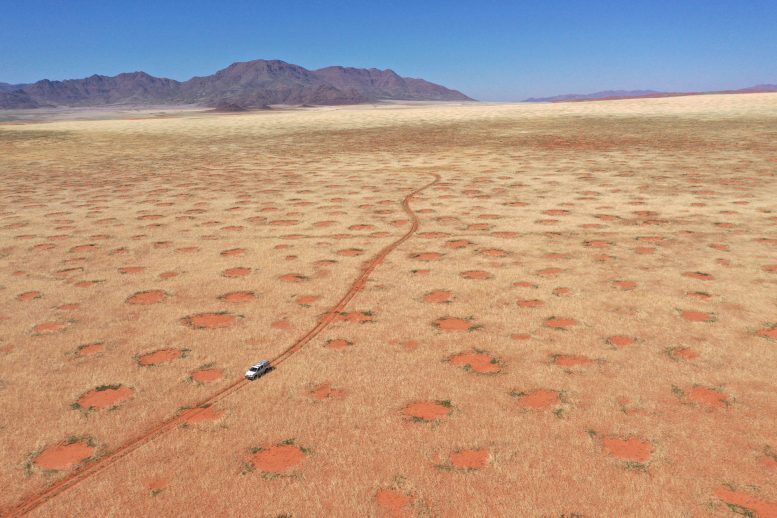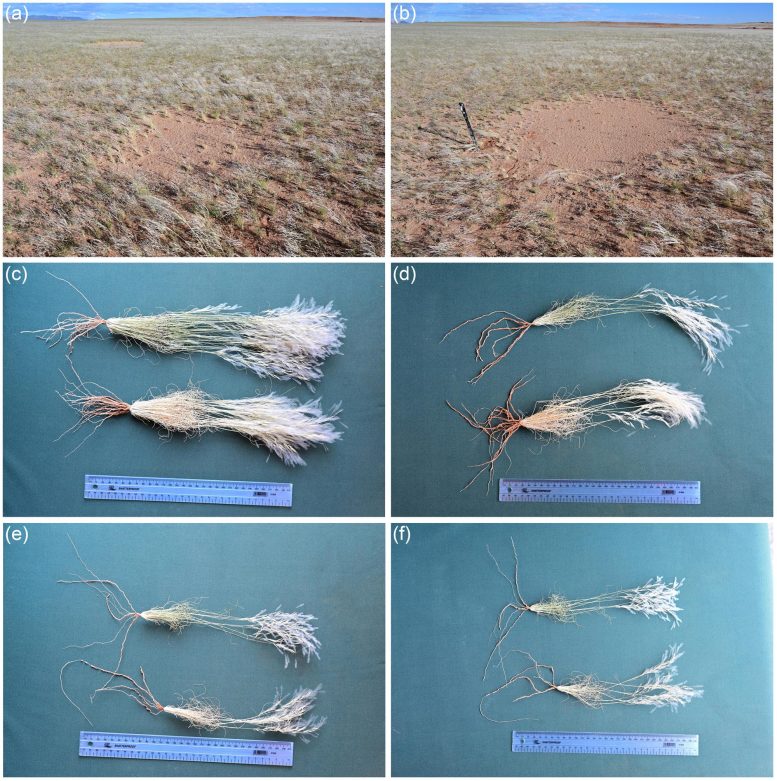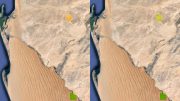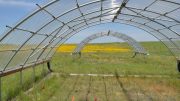
Drone image of a car driving through the NamibRand Nature Reserve, one of the fairy-circle regions in Namibia where the researchers undertook grass excavations, soil moisture, and infiltration measurements (April 2022). Credit: Dr. Stephan Getzin
Inexplicable circles are caused by plant water stress, not termites, according to research from Göttingen University.
For almost 50 years, researchers have been perplexed by the origin of Namibia’s fairy circles. It came down to two primary hypotheses: either termites were responsible or plants somehow managed to organize themselves. Now, researchers from the University of Göttingen have shown that the grasses inside the fairy circles perished shortly after rainfall in the Namib Desert, but termite activity did not cause the bare patches.
Instead, continuous observations of soil moisture show that the grasses surrounding the rings strongly depleted the water inside them, which most likely contributed to the mortality of the grasses inside the circle. The findings were recently published in the journal Perspectives in Plant Ecology, Evolution, and Systematics.
Millions of fairy circles may be found in the Namib, between 50 and 90 miles (80 and 140 kilometers) from the coast. These circular holes in the grassland are each a few meters wide, and collectively they create a recognizable pattern that can be seen for miles around. The researchers studied sporadic rain events in numerous desert regions and analyzed grasses, their roots and shoots, and potential termite root damage.
A researcher investigates the death of grasses inside fairy circles in a plot near Kamberg in the Namib. The recording was made about a week after rainfall (March 2020). Credit: University of Göttingen
Termites, tiny insects that live in large colonies around the world, have often been blamed for the death of the grasses. The researchers took great care to investigate the circumstances of dying grasses within fairy circles right from straight after the rainfall, which triggered the new growth of the grasses. Additionally, they installed soil-moisture sensors in and around the fairy circles to record the soil-water content at 30-minute intervals starting in the dry season of 2020 to the end of the rainy season of 2022.
This enabled the researchers to record precisely how the growth of the new emerging grasses around the circles affected the soil water within and around the circles. They investigated the differences in water infiltration between the inside and outside of circles in ten regions across the Namib.

Researchers investigated grass death within the fairy circles in several regions of the Namib. The roots of the yellowish dead grasses from within the fairy circles are as long and as undamaged as the roots of the vital green grasses outside of the circles. There was no sign of termite activity. Credit: Dr. Stephan Getzin
The data show that about ten days after rainfall, the grasses were already starting to die within the circles while most of the interior area of the circles did not have grass germination at all. Twenty days after rainfall, the struggling grasses within the circles were completely dead and yellowish in color while the surrounding grasses were vital and green.
When the researchers examined the roots of the grasses from within the circles and compared them to the green grasses on the outside, they found that the roots within the circles were as long as, or even longer than, those outside. This indicated that the grasses were putting effort into the growth of roots in search of water. However, the researchers found no evidence of termites feeding on roots. It was not until fifty to sixty days after the rainfall that root damage became more visible on the dead grasses.
Dr. Stephan Getzin, Department of Ecosystem Modelling at the University of Göttingen, explains: “The sudden absence of grass for most areas within the circles cannot be explained by the activity of termites because there was no biomass for these insects to feed on. But more importantly, we can show that the termites are not responsible because the grasses die immediately after rainfall without any sign of creatures feeding on the root.”

Co-author, Sönke Holch, downloading data from a data logger in the Namib in February 2021 when the grasses reached their peak biomass. Credit: Dr. Stephan Getzin
When the researchers analyzed the data on soil-moisture fluctuations, they found that the decline in soil water inside and outside of the circles was very slow after initial rainfall, when grasses were not yet established. However, when the surrounding grasses were well established, the decline in soil water after rainfall was very fast in all areas, even though there were almost no grasses within the circles to take the water.
Getzin explains: “Under the strong heat in the Namib, the grasses are permanently transpiring and losing water. Hence, they create soil-moisture vacuums around their roots and water is drawn toward them. Our results strongly agree with those of researchers who have shown that water in soil diffuses quickly and horizontally in these sands even over distances greater than seven meters.”
Getzin adds: “By forming strongly patterned landscapes of evenly spaced fairy circles, the grasses act as ecosystem engineers and benefit directly from the water resource provided by the vegetation gaps. In fact, we know related self-organized vegetation structures from various other harsh drylands in the world, and in all those cases the plants have no other chance to survive except by growing exactly in such geometrical formations.”
This research has implications for understanding similar ecosystems, especially with regard to climate change, because the self-organization of plants buffers against negative effects induced by increasing aridification.
Reference: “Plant water stress, not termite herbivory, causes Namibia’s fairy circles” by Stephan Getzin, Sönke Holch, Hezi Yizhaq, and Kerstin Wiegand, 20 October 2022, Perspectives in Plant Ecology, Evolution and Systematics.
DOI: 10.1016/j.ppees.2022.125698
The study was funded by the German Research Foundation.









The shape and size of the ‘circles’ are reminiscent of Bison Wallows in North America. From the National Park Service: “Across the Great Plains, it is estimated that there may have once been five or more very small to very large bison wallows per acre.”
I’m not convinced that we have the final answer on this.
highly unlikely that termites are to blame ; mutual benefits are the name of the game in nature unless you have a new man-induced invasive species like chestnut blight in America.
All the more obvious that fairies are involved.
Death Valley (Calif.) exhibits small features similar to these Fairy Circles. A commonly accepted explanation is that as feral burrows urinate, the high concentration of nutrients in the potentially fertilizing urine actually sterilizes the soils and kills vegetation in the center — not unlike one’s lawn fertilizer spreader that has a leak, causing streaks where the grass is ‘burned.’ There is, however, a zone around the center where the additional urea and phosphorus is beneficial to the growth of vegetation; the urine does not reach beyond that.
If these features are caused by large herbivores rolling in these dusty spots, they may likely urinate and/or defecate, either purposely as scent marking, or just unconcerned behavior. The researchers should have done soil chemistry analysis to see if there was a nutrient gradient from the center to the periphery. Now days, it might even be possible to look for DNA to find a likely animal responsible.
I note that the location of the Namibian Fairy Circles is flat ground with short grass. It would be a place where large predators would be spotted easily. Therefore, animals might feel safe enough to get off their feet and roll in the dust.
It looks like these researchers only considered one working hypothesis and didn’t gather enough data to rule out other possibilities.
They said, “… continuous observations of soil moisture show that the grasses surrounding the rings strongly depleted the water inside them, which most likely contributed to the mortality of the grasses inside the circle.” I don’t think that they have made a compelling case for cause and effect — only a correlation.
“… have shown that the grasses inside the fairy circles perished shortly after rainfall in the Namib Desert, …”
What this means is that transpiration is effective during photosynthesis. Once the grasses become senescent, evaporation will dominate in the loss of soil moisture. Therefore, the vegetated areas, whose shadow reduces direct surface insolation, will lose water more slowly than the bare areas that will heat more in the sun. Why should the grasses on the periphery be able to out-compete the grasses in the center, closer to the water? It seems to me that they are missing something.
further into the article they explain, “By forming strongly patterned landscapes of evenly spaced fairy circles, the grasses act as ecosystem engineers and benefit directly from the water resource provided by the vegetation gaps. In fact, we know related self-organized vegetation structures from various other harsh drylands in the world, and in all those cases the plants have no other chance to survive except by growing exactly in such geometrical formations.”
Wow it only took 50 years to figure that out!!!! What a joke
No mention of a possible fungal cause. The circle pattern reminds me of a ring of mushrooms that can form around a mushroom from the night before. A fungus with spores that are activated by water…?
As soon as I saw the circles I thought “fungi”. Fungi also plays a critical, symbiotic role with a plant root.
Is it just one grass species?
I strongly believe it is caused by the geo-engineering program that has been going on by the global miliatary industrial complex’s space program. This startsd around World War2 and has been accelerated the past 15 years. It’s about controlling the weather and blocking the Sun.
Do you have any good evidence for your belief? If weather could be controlled, I would expect weather forecasts to be more accurate than they are. Precipitation forecasts are often wrong the same day they are made.
5 decade joke!
That cannot be the reason, what about the grass on the edge of the circles?